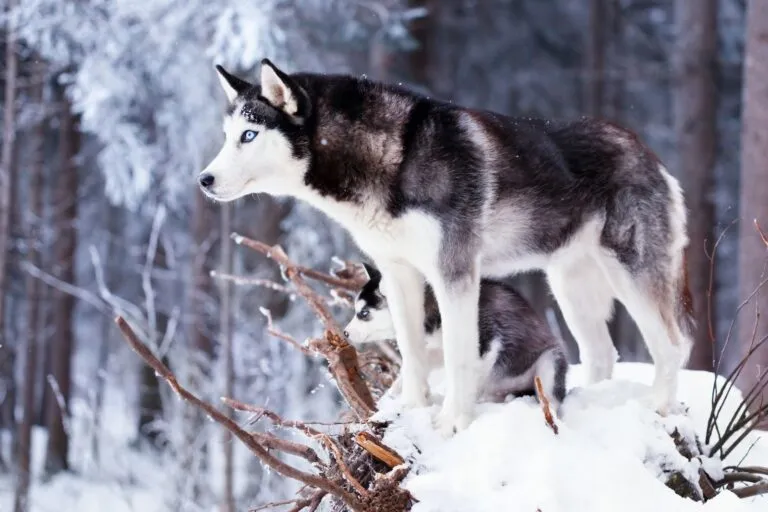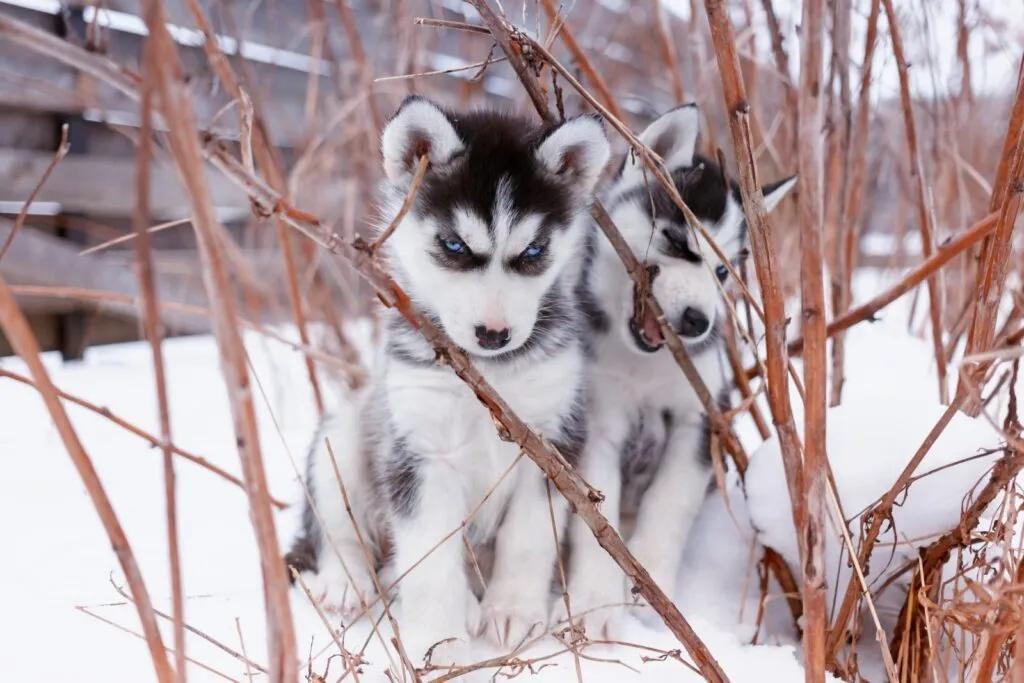Medium Size Poodle
Sparkling blue eyes and a distinctive coat pattern distinguish the Siberian Husky. Its Nordic beauty conjures images of wintry landscapes. Increasingly, this sled dog is also found parading through more southern regions, becoming ever more popular with families. Discover what you need to consider when keeping these four-legged friends.

© Volha / stock.adobe.com
The Siberian Husky loves exercise, preferably outdoors.
Even novices can recognise the distinctive sled-dog look and Nordic charm of the Siberian Husky at first glance.
The breed is particularly known for its blue eyes, which lend a cool elegance to its appearance. However, there are also individuals with amber eyes or “odd-eyed” dogs, featuring one blue and one brown eye.
Most members of the breed boast a richly coloured back pattern. The belly, chest, and legs are white, and many Huskies sport a multicoloured “mask” on their faces. Their medium-sized, thickly furred ears stand close together and are set high on the head.
The Husky’s coat also offers protection against the cold with several characteristics:
The Huskys’ rounded tail – the so-called sickle tail – has little undercoat and serves a practical purpose: During snowstorms, the dogs curl up and tuck their noses under the tail, which acts as an air filter, warming up the air before it is breathed in.
Their paws and fur are more suited to Siberian cold rather than Central European climates. Their paws are smaller than those of similar-sized dogs, which results in less heat loss.
The Siberian Husky is often confused with the less well-known Alaskan Malamute. It is another Nordic sled dog similar to the Husky in fur and proportions.
However, the Siberian Husky is much more slender: It reaches a height at the withers of approximately 50 to 60 centimetres and a maximum weight of 28 kilograms.
As a guard dog, the Siberian Husky won’t impress. They’re simply too friendly towards people. This is by design, as these animals should follow all sled drivers, therefore, the most cooperative are chosen for breeding.
However, most are independent dogs with a significant hunting instinct. Some Siberian Huskies are skilled at ignoring their owner’s calls. Those considering a Husky should thus place great emphasis on training. Not every Husky can be trained to be reliably off-lead at all times.
On the plus side, these northern beauties rarely bark. Instead, they attract attention with wolf-like howling. It’s best not to give your Husky any reason to complain.
They’re happiest when allowed to move. After all, running is what they were bred for. An under-engaged Siberian Husky will otherwise find its own amusement.
Caring for a Siberian Husky is straightforward: Their fur is easy to comb and only needs a little extra attention during the shedding season. Grooming helps control the hair loss, which can be significant during that time.
Bathing your four-legged friend isn’t recommended. Most dirt can simply be wiped off with a dry towel or combed out. If a bath is absolutely necessary, use only water and a mild dog shampoo.
Ideally, Huskies thrive in a house or apartment with a secure garden where they can stay active between walks and runs. But beware: many Huskies love to dig holes in the garden – so those who cherish a well-manicured lawn should reconsider their priorities before welcoming one of these energetic dogs.
If you decide to keep your Husky in the garden, consider giving it a canine companion. Family connections are very important to them, and dogs are used to large packs and dislike being alone. Complaints from a lone Husky may come in the form of howling. A second dog in the household ensures companionship in your absence.
To this day, the Siberian Husky remains an essential work animal among the Inuit and is an integral part of the family. That’s why the breed is also very popular as a family pet in other countries. The ideal family for a Husky is active and enjoys an energetic four-legged leisure partner.
Cat lovers with a wish for a Husky should, ideally, socialise them with cats from a puppy age – fully grown Huskies tend to see our little feline friends as nothing more than prey due to their hunting instinct.
A Siberian Husky loves to move around as much as possible. Accustomed to life in the cold, they truly come into their own when most of us are reaching for gloves in the brisk weather. If you’re still excited to venture outdoors with the first autumn winds, then you share an essential hobby with the Siberian Husky.
However, even in the summer, Huskies are not lazy. Make sure to watch out for your Husky in high temperatures, ensuring it doesn’t overexert itself and can cool down in a shady spot when needed.
These Northern dogs excel at running – whether it’s next to a bicycle or during a jog. Dog Dancing or Agility might not be their main strengths, although there are always exceptions to the rule.
Of course, the supreme discipline for the Siberian Husky remains sled dog sport, where they might, for example, pull a sled. There are numerous ways to get involved with this thrilling dog sport with your canine pal in Germany.
The average lifespan of a Siberian Husky is between ten and fourteen years. They are rarely ill and do not often present breed-specific ailments.
Despite their fitness and efficient musculoskeletal system, these dogs should not be overworked – especially during their growth phase. Muscles for extended running, required for activities like cycling or sledding, should be developed gradually, ideally once they are fully grown.
When purchasing from a breeder, ensure the husky’s ancestors have been examined for hip dysplasia before breeding.
Siberian Huskies also have a tendency toward zinc-reactive dermatosis. This condition arises when the intestine fails to absorb enough zinc from regular food, potentially causing skin problems, among other issues. In this case, lifelong zinc supplements may be required in consultation with your vet.
The forebears of today’s Huskies lived in Siberia, where they were indispensable to the nomadic tribes.
These resilient fur-friends gained fame in 1909 when Siberian fur trader William Goosak entered his dogs in the “All Alaska Sweepstakes” sled dog race.
His team came in third place in the 408-kilometre-long, challenging race, offering strong competition to the well-established Alaskan Malamutes.
In the following year, dogs of Siberian lineage took the lead positions once again. This prompted the Norwegian sled dog driver Leonhard Seppala to establish the first official Husky kennel in Alaska using William Goosak’s dogs.
Few other dogs remain as closely linked with their original purpose as the Siberian Husky. They are leaders in sled pulling and navigation. When necessary, they can pull nine times their body weight and find their way even in snowy surroundings.
The human partnering them is known as the Musher. He always keeps the lead taut to prevent injuries to the dogs. He directs the team solely with voice commands, which the lead dog must implement without question.
There are sled dog associations across Europe that organise competitions. Just like in 1909, Siberian Huskies participate.
In Alaska and Canada, extreme sled dog races are conducted under harsh climatic conditions, and these events have started to draw criticism. Man and beast are sometimes required to cover over 1,000 kilometres.
 © Volha / stock.adobe.com
© Volha / stock.adobe.com
Those wishing to welcome a Siberian Husky into their family should seek out a reputable breeder. They will answer all your questions regarding the dogs’ health, breed-specific health care, proper nutrition, and training.
Your first puppy experience is best enjoyed at the breeder’s home, where you can also meet the pup’s parents. In the best-case scenario, the breeder will similarly vet you to ensure you can offer a good, species-appropriate home for your chosen puppy.
Look for breeders affiliated with dog associations or clubs and steer clear of buying a pedigree dog without papers, even if they come with a tempting price tag. The apparent pedigree dog bargain can quickly become a costly affair.
Missing healthcare, vaccinations, or hygiene measures for the puppies will later result in high veterinary bills. Improperly socialised animals can also cause trouble for owners and suffering for the dogs.
Fans of the breed can find reputable Siberian Husky breeders through national dog associations. Those looking for an adult dog or with a soft spot for Husky mixed breeds should start with Husky in need organisations, in animal shelters, or with sled dog aid groups.
Foster carers will help you identify the perfect canine match. No matter if they are from a breeder or shelter: A vaccination record is always essential.
It’s no surprise that Siberian Huskies have many admirers: Their exceptional appearance and friendly, animated nature enchant both seasoned dog enthusiasts and newcomers alike. Those wishing to keep a Husky should carefully consider whether they can meet the breed’s needs.
Originally bred as sled dogs, even as family pets, they require plenty of exercise. Ample space and cooler temperatures make for a wholly content Husky. If you’re also eager to get outside with the first autumn chills, then you share a crucial passion with the Siberian Husky.
| Quick Info: | The medium-sized Siberian Husky is robust and enduring. As a sled dog, they adore racing and are mainly used in sled dog sports. They are active leisure companions and beloved family pets. |
| Height at Withers: | 50-60 cm |
| Weight: | 16-28 kg |
| Average Lifespan: | 10-14 years |
| Price: | approx. 1,500 Euros |
| Temperament: | friendly, gentle, sociable, strong hunting instinct |
| Coat: | short and very dense |
| Coat Colour: | all colours permitted |
| Training Effort: | moderate |
| Grooming Effort: | low |
| Exercise Requirements: | high |
| Origin: | Northern Siberia |
Here are some purchase proposals curated by the zooplus editorial team
The products featured have been carefully selected by our editorial staff and are available at the zooplus online pet shop. The selection does not constitute advertising for the mentioned brands.
Fans of the Bearded Collie agree that those who aren't familiar with this dog breed simply have to get acquainted with it. And those who have experienced how a Bearded Collie bolts across meadows with its flowing fur, how it rolls around full of energy and joy and how it attentively and observantly takes into account its owners wishes become simply addicted to this original dog breed and its unique charm.
The Goldendoodle isn't a breed, but a pairing between Golden Retrievers and Medium or Standard Poodles. Marketed as a low-maintenance dog for allergy sufferers, this hybrid is enjoying increasing popularity amongst dog lovers, similar to the Labradoodle.